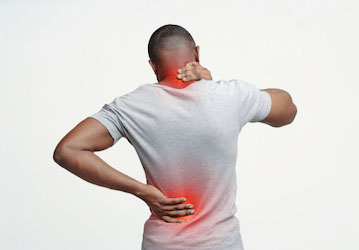Back pain is a complex condition that can have many causes. It could be from a physical injury to the spine, ribs, or back muscles. It could also be caused by mental health conditions such as depression. Be sure to see your healthcare provider for proper diagnosis and treatment. Meanwhile, read on to learn about back pain and some tactics to help manage it.
Understand back pain
In most cases—up to 85%—back pain is what’s called “nonspecific,” which means there’s no known physical cause or physical injury that needs to be fixed. While this is a good thing, it also makes managing back pain complicated.
When you report back pain to your medical provider, they should go through a checklist of your signs and symptoms. This will help them decide if your pain is nonspecific, or if it might be caused by a physical injury or other condition. Once they determine you have nonspecific pain, they probably won’t order x-rays, MRIs, or other advanced imaging. This is because taking those images is expensive and time-consuming, and it often leads to finding “issues” that might not be the problem. Overusing imaging for back pain also can lead to unnecessary surgeries that don’t improve your pain any better than if the images were never taken and surgery wasn’t performed.
Nonspecific back pain has what’s called a “natural course.” Most cases are called “acute” pain, where it lasts 4–6 weeks. Most of these cases will go away on their own without treatment. Pain enters the “subacute” phase when it continues for 6–12 weeks without going away or reducing in severity. If pain persists for at least 12 weeks, it has become chronic pain, which is difficult to treat without holistic pain-management strategies.
Red flags
When someone reports back pain, there are only a few seriously concerning signs and symptoms that medical providers keep an eye out for.
- Electric or fire-like pain shooting down one or both arms or legs
- Unrelenting night pain that might be OK or tolerable during the day, but gets much worse at night and keeps you from sleeping
- Unexplained weight loss or losing weight quickly when you’re not trying to
- Bowel or bladder changes
- Fever
- Cancer or a history of cancer
If you experience any of these symptoms, make an appointment to see medical as soon as possible. If it’s less serious, your provider likely won’t order advanced imaging unless your current bout of pain has continued for at least 6 weeks.
Manage back pain
The first step for managing back pain is to stay active. Avoiding activities that you fear will make your pain worse, whether or not they actually will, can lead to worse or longer lasting pain. Instead, keep moving and try to live as close to normal a physical life as possible. That means keep walking and participating in physical activity.
The good news is that there’s light at the end of the tunnel. Knowing that most cases of acute back pain resolve on their own help you keep a positive mindset and enable you to take control of the things you can. Even if you can’t stop your back from hurting completely, controlling what you can—like staying active, for example—can help reduce the severity.
Next, practice strategic avoidance. Limit heavy lifting and doing other things that you know will strain your back. It’s also important to modify exercise to limit back-straining lifts until your pain lessens. Exercises such as deadlifts, if not done properly, can make pain worse.
When you do work out, add in exercises that strengthen your butt and hamstrings and stretch your quads and hip flexors. Low-level exercises such as glute bridges are really good for this. Once you’ve been cleared by a medical provider, HPRC’s Rx3 low back pain program has these exercises.
 Find out how to work out around exercise limitations Learn More
Find out how to work out around exercise limitations Learn More
Not all pain-management strategies are physical. Engaging your social support network to help keep you optimistic and motivated through your bouts of pain can help you push through it. Social support can also help manage some of the things that might contribute to the causes of pain such as depression or anxiety.
Remember that back pain can have many causes. Check out the Defense & Veterans Center for Integrative Pain Management’s (DVCIPM) video series for more information on good pain care.
